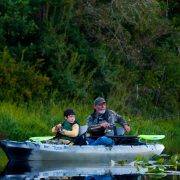In the last decade, cleanup efforts have lead to an explosion in Stand up Paddleboarding, kayaking, and tubing on our mountain rivers and streams. Kayak fishing has taken off in Western North Carolina over the past couple of years as a relaxing and affordable way to get off the bank and access remote waters. Kayaks offer a stealth means of approaching easily spooked fish, but there are a few tips you should know.
Kayak fishing has gained popularity locally due to its broad appeal as an eco-friendly way to have fun and get exercise, as well as its relatively low cost of entry compared to motorized boats. The most popular kayaks for fishing are rotationally molded from polyethylene due to their durability and lower cost. The new generation of catamaran (twinhull) kayaks are stable enough to enable both paddling and fishing in the standing position, offering greater versatility and angling efficiency. This development solves some ergonomic problems that are associated with sitting for long hours without being able to change positions and frees you from the need to sacrifice speed for stability.
The French Broad River, which cuts through the region, offers great kayak fishing for small mouth bass, trout, and musky. The easy portability of a kayak gives access to waters otherwise off-limits to powerboats, which often means a bounty of eager-to-bite fish. A couple of hours of catch-and-release fishing after work or on the weekends provide some great healthy relaxation.
Unlike lake fishing, river fishing can swing pretty heavily with water conditions. When the river is high and currents are swift, it’s not a good time to be on the water – nor is fishing going to be great after a hard rain. Ideal conditions are when the river is slightly gloomy and low. (As an aside, the French Broad River is very clean. It’s rarely clear, but that’s because the banks are eroded, leading to sediment and runoff when it rains. However, it’s a designated drinking water source for more than a million people.)
A great place to put in is just north of Asheville city limits in Woodfin. There are several riverside parks along NC 251 with boat access. Since it’s past the wastewater treatment plant, you’ll find larger fish. There’s a lull in August and September, but it’s not uncommon to see one or two fish around 14-16 inches an hour during the rest of the year.
The latest generation of fishing kayaks can be found for $1,000 to $3,000. Beyond the substantially lower cost upfront cost, kayak anglers spend less on towing fuel costs, insurance, maintenance, and launch fees. If you’ve been debating getting into kayak fishing, there’s never been a better time to start than now.





